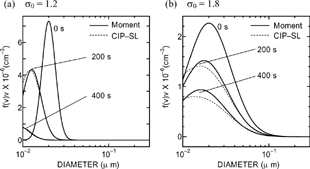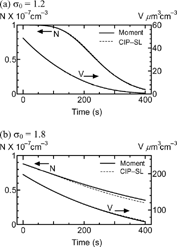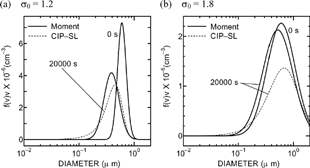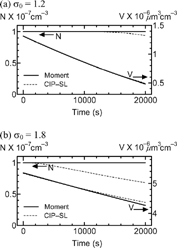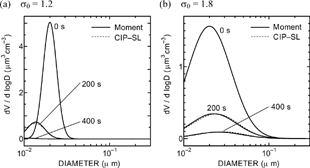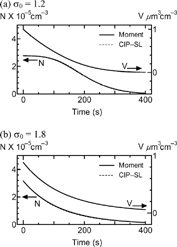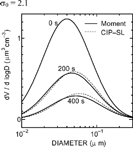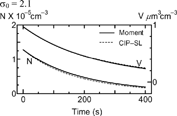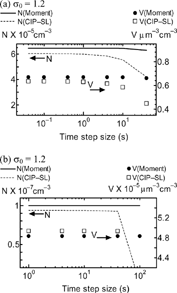A moment method of the log-normal distribution with the smallest size is applied to evaporation by newly introducing correction factors obtained from the error function. In this article, the improved moment method is tested for the evaporation, and is compared with the exact solutions calculated by the CIP semi-Lagrangian (CIP-SL) method. In small particle regime, the size distributions and the time histories of the total number and volume per unit volume are reproduced by the moment method for the evaporation near the smallest size. In large particle regime, however, the differences between the moment and exact solutions are larger with time, after the exact distribution spreads to the smallest size. This new moment solver can reproduce the evaporation near the smallest size even when large time step size is given, and thus is expected to be used for the parameterization of the evaporation of small particles in aerosol-transport model.
INTRODUCTION
Moment methods of the log-normal size distribution are used for simulations of aerosol dynamics. In these methods, the size distribution parameters (geometric mean size and standard deviation) can be directly obtained from the three moments of the size distribution in an entire size region from 0 to ∞ . Since the moment method is simple and efficient (e.g., CitationLee et al. 1984; CitationPratsinis 1988; CitationPark et al. 1999), this method has been incorporated into aerosol-transport models as the parameterization of microphysical processes (e.g., CitationBinkowski and Shankar 1995; CitationYamamoto and Tanaka 1998).
The moment method for evaporation has been developed by several researchers (e.g., CitationBrock and Oates 1987; CitationSeo and Brock 1990). Under the condition that the smallest volume v S is sufficiently small, CitationBrock and Oates (1987) applied the moment method to the semi-infinite domain from v S to ∞ . The moments integrated from 0 to ∞ cannot be applied to the evaporation near v S . Although the correct moment value should be calculated by using the error function in the case of v S ≠ 0 (as will be discussed in this article), the error function has not been considered in previous studies of moment methods. At the present stage, under the condition that the peak volume of the log-normal size distribution is close to the smallest volume v S , the moment method for the evaporation with the smallest size has not been in detail studied as yet. In this article, I propose a new moment method for the evaporation near v S , in which the error function is utilized in order to accurately calculate the moments (the total number and volume of particles).
The qth order logarithmic distribution of CitationEspensheid et al. (1964) is defined by
Instead of LND, the volume log-normal distribution (VLND) is also used in aerosol simulations (e.g., CitationSeigneur et al. 1986; CitationZhang et al. 1999). The volume-weighted distribution is expressed as
In Equation[4], Equation[5], Equation[6], Equation[7], v M and σ M are the size parameters of the −4th order logarithmic distribution f −4(v). As discussed in the previous section, since VLND and MLND can be easily obtained from Equation[4], Equation[5], Equation[6], Equation[7] using the −4th order logarithmic size parameters, f −4(v) is available for the moment methods of VLND and MLND.
The modal mean volume obtained from the moments is different among LND, ZOLD, and VLND (MLND). In the moment method, the governing equations described by the size parameters (v M and σ M ) depend on the assumed distribution function. If the qth order logarithmic function of CitationEspensheid et al. (1964) is introduced into the moment method, the moment equations of LND, ZOLD, VLND, and MLND can be unified to a same equation of the qth order logarithmic distribution. Thus, LND (q = −1), ZOLD (q = 0), VLND (q = −4), and MLND (q = −4) can be easily incorporated by appropriately choosing q in a same moment solver. Although CitationYamamoto (2004a) applied the qth order logarithmic function to the Brownian coagulation, other processes have not been considered as yet. In this study, the qth order logarithmic distribution of CitationEspensheid et al. (1964) is utilized for evaporation process, in order to easily incorporate various logarithmic functions into the moment method.
The moment method in the semi-infinite domain from v S to ∞ should be developed to simulate the evaporation near v S . In this article, the moment equation with the smallest size is derived on the basis of the qth order logarithmic function. The improved moment method for the evaporation is tested, and is compared with the exact solutions obtained from the semi-Lagrangian solver (CitationYamamoto 2004b).
MOMENTS OF THE LOGARITHMIC FUNCTION WITH THE SMALLEST SIZE
The moments of the qth order logarithmic function Equation[2] in the semi-infinite size region from v S to ∞ are discussed in this section. The kth order moment is written as
The above relation is obtained from Appendix A. As v S is approached to zero, the correction factor α k becomes unity. Instead of the M k integrated over the semi-infinite region from v S to ∞, we introduce the moment m k satisfying the following relation;
From Equation[8] and Equation[12], m k is written as
In previous moment methods, the moment integrals from 0 to v S are remained as the errors of the total number (M 0) and the total volume (M 1). When v M ∼ v S , the errors cannot be neglected in the moment calculation. On the other hand, the new method can accurately calculate the moment integrated from v S to ∞ on the assumption of the logarithmic size distribution (Equation[8], Equation[9], Equation[10], Equation[11]), since the moment errors due to the integrals from 0 to v S are removed by introducing the correction factor α k .
BASIC EQUATIONS
The governing equation is described by
From the relation Equation[12], since
For the small particle regime, the evaporation moment equation is
TESTS
To examine the validity of the above method, the numerical solutions are compared with the exact solutions calculated by the CIP semi-Lagrangian (CIP-SL) solver using cumulative number distribution (CitationYamamoto 2004b) on the basis of the cubic interpolated propagation (CIP) method (e.g., CitationYabe and Aoki 1991; CitationYabe et al. 2001). The initial and experimental conditions are listed in and . For Tests I–IV, the initial conditions are written as
TABLE 1 Initial conditions
TABLE 2 Experimental conditions
The smallest diameter is set at 0.01 μ m for all calculations. In the moment method, the governing moment equations are solved by the fourth order Runge-Kutta method. In the CIP semi-Lagrangian method, the J-space grid system of a = 1.2, b = 1.0, r 1 = 0.005 μ m (r 1 is the radius of the particle of J = 1 in the J space) is utilized (CitationYamamoto 2004b).
shows the size distributions in the small particle regime (Tests I and II). Equations Equation[26], Equation[27], Equation[28], Equation[29], Equation[30], Equation[31], Equation[32] are solved in the moment method. As the initial geometric standard deviation σ 0is wider, the difference of the size distribution from the exact solution (dashed curve) is larger. For small σ0(= 1.2), the total volume per unit volume V rapidly decreases with time. When the particles spread to the smallest size (t ≈ 75 s), the total number per unit volume N begins to decrease with time in . Even when aerosols are almost evaporated at 400 s (Test I), the relative errors of N and V are 7.2% and 5.6%, respectively. For large σ0(= 1.8), N and V are slowly decreased, since many particles remain in large size region. Although the relative error of N is large (12% at 400 s), the error of V is small (2.9%) in (Test II).
shows the size distributions in the large particle regime (Tests III and IV). Equations Equation[34], Equation[35], Equation[36], Equation[37], Equation[38], Equation[39], Equation[40] are solved in the moment method. The distribution for the exact solution is deviated from the log-normal function. The asymmetry across the peak diameter (dashed curves in ) increases with time. After small particles reach to the smallest size, N decreases with time in the CIP-SL method. On the other hand, N is constant in the moment method, since the distribution does not spread to the smallest size. The differences between the moment and CIP-SL methods cannot be ignored in . Since the removal of particles at the smallest size v S is not simulated in the moment method for the large particle regime, the difference between the two methods is larger with time for N (). Although the error of N is large (6.6% in Test III and 46% in Test IV at 20000 s) in the moment method, V has relatively small error (2.1% in Test III and 2.3% in Test IV at 20000 s) in comparison with N. The error of V is cancelled because of relatively high number concentration in smaller size region.
shows the volume distributions in the small particle regime (Tests V–VII). Equations Equation[26], Equation[27], Equation[28], Equation[29], Equation[30], Equation[31], Equation[32] are solved in the moment method. In the cases of σ 0 = 1.2 and 1.8, although the slight differences between the two methods appear in and , the distributions are well reproduced. The time histories of N and V for the moment method are almost the same as those for the CIP-SL method in and . The relative errors of N are 3.5% in Test V and 6.5% in Test VI at 400 s, and the errors of V are 3.2% in Test V and 3.9% in Test VI. Even when large σ 0 (= 2.1) is initially set in Test VII, the differences between the two methods are not extraordinarily large in and (14% for N and 4.9% for V at 400 s).
shows the sensitivities of N and V to time step size dt. For the CIP-SL method, the time step size smaller than 1 s is required to accurately calculate N and V in Test I, and the value smaller than 10 s is required in Test III. In the cases of large time step size, N and V become smaller, as dt is larger. On the other hand, N and V for the moment method are not dependent on dtin . We can choose large time step size in the moment method.
The computational cost was measured on our computer system (Intel Xeon processor of 1.7 GHz), in which Compaq Visual Fortran ver. 6.5. was installed on the Windows 2000 OS. In the moment calculation, the error function DERFC is called from the numerical library IMSL. The evaporation coefficients (β FM , β CO , γ FM , and γ CO ) are recalculated at each stage of the fourth order Runge-Kutta scheme with four stage time integration. In the CIP-SL calculation (CitationYamamoto 2004b), the integrals over the size region (such as the total volume, mass, and surface area per unit volume) are not calculated at each time step in this measurement. Thus the CIP-SL solver is simple and efficient. For a time-step size of 0.04 s in Test I, the CPU time of the Runge-Kutta moment method (5.16 × 10−1 s) is longer than that of the CIP-SL (1.56 × 10−1 s). The inefficiency of the moment method is caused by the inefficient time-integration scheme. Since the accuracy of the new moment method is mainly examined, the efficiency of time integration scheme is ignored in the present study and the program is not optimized. Instead of the fourth order Runge-Kutta scheme, other efficient schemes utilized for solving chemical reaction equation (e.g., CitationJacobson 1999) should be chosen in the moment parameterization of microphysical processes.
CONCLUSIONS
A moment method of the log-normal distribution with the smallest size v S is developed by newly introducing correction factor α k on the basis of mathematical relationships of Equation[12], Equation[13], Equation[14], Equation[15]. In this study, the qth order logarithmic function of CitationEspensheid et al. (1964) and the error function are applied to the moment method for the evaporation in the semi-infinite domain from v S to ∞ . Since LND, VLND, and ZOLD can be expressed by the qth order logarithmic distributions (f − 1, vf − 4, and f 0, respectively), these distribution functions can be easily utilized by appropriately choosing q in a moment solver using f q (v). In the same way as previous moment method in the entire domain from 0 to ∞, the simple moment equations derived in this study can be utilized for the evaporation under the condition of v S ≠ 0.
The improved moment method is tested for the evaporation, and is compared with the exact solutions calculated by the CIP semi-Lagrangian (CIP-SL) method. In small particle regime, the size distributions for the evaporation are well reproduced, unless the initial standard deviation is large. In addition, we can reproduce the time histories of the total number and volume per unit volume, even when the size distribution is located near v S . In large particle regime, however, the size distribution is different from the exact one. After the exact distribution reaches to the smallest size, the differences between the two methods increase with time.
The results for the moment method are not dependent on the time step size dt. For the evaporation near the smallest size v S , although sufficiently small time step size is required in the CIP-SL simulation, large time step size can be set in the moment method.
As mentioned in the previous section, LND and VLND (also ZOLD) are easily utilized in a moment method of the qth order logarithmic distribution in the semi-infinite domain from v S to ∞ . This new moment solver can reproduce the evaporation near the smallest size v S even when large time step is given, and thus is expected to be used for the parameterization of the evaporation of small particles in aerosol-transport model.
REFERENCES
- Binkowski , F. S. and Shankar , U. 1995 . The Regional Particulate Matter Model 1. Model Description and Preliminary Results . J. Geophys. Res. , 100 : 26191 – 26209 . [CSA]
- Brock , J. R. and Oates , J. 1987 . Moment Simulation of Aerosol Evaporation . J. Aerosol Sci. , 18 : 59 – 64 . [CROSSREF] [CSA]
- Espenscheid , W. F. , Kerker , M. and Matijevic , E. 1964 . Logarithmic Distribution Functions for Colloidal Particles . J. Phys. Chem. , 68 : 3093 – 3097 .
- Gras , J. L. and Laby , J. E. 1979 . Southern Hemisphere Stratospheric Aerosol Measurements 2. Time Variations and the 1974–75 Events . J. Geophys. Res. , 84 : 303 – 307 . [CSA]
- Jacobson , M. Z. 1999 . Fundamentals of Atmospheric Modeling , Cambridge : Cambridge Univ. Press . 656
- Lee , K. W. , Chen , H. and Gieseke , J. A. 1984 . Log-Normally Preserving Size Distribution for Brownian Coagulation in the Free-Molecule Regime . Aerosol Sci. Tech. , 3 : 53 – 62 . [CSA]
- Park , S. H. , Lee , K. W. , Otto , E. and Fissan , H. 1999 . The Log-Normal Size Distribution Theory of Brownian Aerosol Coagulation for The Entire Particle Size Range: Part I—Analytical Solution Using the Harmonic Mean Coagulation Kernel . J. Aerosol Sci. , 30 : 3 – 16 . [CROSSREF] [CSA]
- Pratsinis , S. E. 1988 . Simultaneous Nucleation, Condensation, and Coagulation in Aerosol Reactors . J. Colloid Interface Sci. , 124 : 416 – 427 . [CROSSREF]
- Quirantes , A. and Delgada , A. V. 1997 . The Scattering of Light by a Suspension of Coated Spherical Particles: Effects of Polydispersity on Cross Sections . J. Phys. D: Appl. Phys. , 30 : 2123 – 2131 . [CROSSREF]
- Quirantes , A. , Plaze , R. and Delgada , A. V. 1997 . Static Light Scattering Study of Size Parameters in Core-Shell Colloidal Systems . J. Colloid Interface Sci. , 189 : 236 – 241 . [CROSSREF]
- Rumminger , M. D. and Linters , G. T. 2002 . The Role of Particles in the Inhibition of Counterflow Diffusion Flames by Iron Pentacarbonyl . Combustion and Flame , 128 : 145 – 164 . [CROSSREF]
- Sassen , K. , Arnott , W. P. , Barnett , J. M. and Aulenbach , S. 1998 . Can Cirrus Clouds Produce Glories? . Applied Optics , 37 : 1427 – 1433 .
- Seigneur , C. , Hudischewskyj , A. B. , Seinfeld , J. H. , Whitby , K. T. , Whitby , E. R. , Brock , J. R. and Barnes , H. M. 1986 . Simulation of Aerosol Dynamics: A Comparative Review of Mathematical Models . Aerosol Sci. Technol. , 5 : 205 – 222 . [CSA]
- Seinfeld , J. H. and Pandis , S. N. 1998 . Atmospheric Chemistry and Physics , New York : John Wiley & Sons . 1326
- Seo , Y. and Brock , J. R. 1990 . Distributions for Moment Simulation of Aerosol Evaporation . J. Aerosol Sci. , 21 : 511 – 514 . [CROSSREF]
- Takahashi , K. 2003 . Fundamentals of Aerosol Sciences (in Japanese) , p. 221. Tokyo : Morikita-Shuppan .
- Toon , O. B. and Pollack , J. B. 1975 . A Global Average Model of Atmospheric Aerosols for Radiative Transfer Calculations . J. Applied Meteo. , 15 : 225 – 246 . [CROSSREF]
- Yabe , T. and Aoki , T. 1991 . A Universal Solver for Hyperbolic Equations by Cubic-Polynomial Interpolation I. One-Dimensional Solver . Computer Phys. Comm. , 66 : 219 – 232 . [CROSSREF]
- Yabe , T. , Tanaka , R. , Nakamura , T. and Xiao , F. 2001 . An Exactly Conservative Semi-Lagrangian Scheme (CIP-CSL) in One Dimension . Mon. Wea. Rev. , 129 : 332 – 344 . [CROSSREF] [CSA]
- Yamamoto , M. and Tanaka , H. 1998 . The Venusian Y-shaped Cloud Pattern Based on an Aerosol-Transport Model . J. Atmos. Sci. , 55 : 1400 – 1416 . [CROSSREF] [CSA]
- Yamamoto , M. 2004a . A Moment Method of an Extended Log-Normal Size Distribution (ELND): Application to Brownian Aerosol Coagulation . J. Aerosol Res. Japan , 19 : 41 – 49 . [CSA]
- Yamamoto , M. 2004b . A Solver for Aerosol Condensation Equation by Semi-Lagrangian Scheme with Correction Exactly Conserving Total Particle Number . Aerosol Sci. Technol. , 38 : 1033 – 1043 .
- Zhang , Y. , Seigneur , C. , Seinfeld , J. H. , Jacobson , M. Z. and Binkowski , F. S. 1999 . Simulation of Aerosol Dynamics: A Comparative Review of Algorithms Used in Air Quality Models . Aerosol Sci. Technol. , 31 : 487 – 514 . [CROSSREF]
APPENDIX A
The integrand of Equation[8] is described as
APPENDIX B
v M and σ M can be derived from Equation[13]. The first and second order moments are written as
